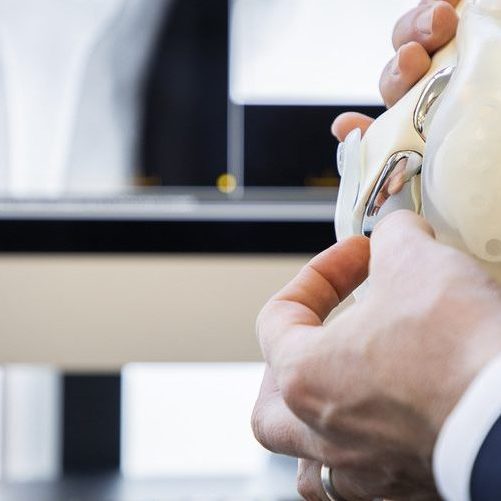Patella joint replacement surgery
A type of partial knee replacement of the joint under the kneecap.
It is a suitable operation for patients with knee osteoarthritis only in this patellofemoral compartment, and who have ongoing disabling pain even after trialling conservative treatment options.

A patellofemoral joint replacement is a type of partial knee replacement of the joint under the kneecap. It is a suitable operation for patients with knee osteoarthritis only in this patellofemoral compartment, and who have ongoing disabling pain even after trialing conservative treatment options. The benefit of this procedure compared to a total knee replacement is that all the ligaments of the knee are preserved along with the rest of the healthy cartilage. The operation is also smaller and typically there is a faster recovery post-operation.
To determine if this procedure is suitable for you, we will perform a thorough clinical examination and history in your first appointment. A recent knee X-ray will be required however in certain cases further imaging such as MRI or CT may also be required to further assess your knee.
If a patellofemoral joint replacement is determined to be suitable for you, we will ensure all steps are taken to ensure an optimal post-operative outcome. We will typically have a physiotherapist give you exercises to optimise the strength of the muscles around your knee. An anaesthetist will assess which anaesthetic plan will be safest and most appropriate for you. We will ensure that if you have any pre-existing medical conditions that they are well managed prior to prior to proceeding with surgery.
The operation is performed under either a general or spinal anaesthetic. A small incision of around 10 cm is made longitudinally down the front of the knee. The undersurface of the patella is exposed with the arthritic surface removed before implanting a polyethylene button as the new articulating surface. The corresponding surface of the distal femur (thighbone) is then replaced with a polished metal component. This allows the polyethylene button to glide smoothly in the groove of the metal component as the knee bends. The bending of the knee with the new components will be tested during the operation, and when the surgeon is satisfied, the surgical incisions will be closed with sutures and covered with dressings. The total operating time is around 90 minutes.
After the procedure, you will be transferred to the post-operative recovery unit to recover from the anaesthetic. Once all your vitals are stable you will be transferred back to the ward. The physiotherapist will see you the day after the operation to practice walking again, initially with a frame. Once you can safely start walking, you will be discharged home to continue the rehabilitation process. Typically, this is around 2-4 days after the operation.
In the first 2 weeks after the operation, activity levels are usually quite limited. The aim is to begin walking independently and perform light exercises given to you by the physiotherapist. After 2 weeks, you will be able to gradually progress in your level of activity, usually resuming most of your regular activities by the 6-week mark. It is important to you adjust your level of exercise to how your body is feeling. Increasing activity levels is beneficial for recovery of function, but this needs to be balanced with overactivity which can worsening swelling and/or pain.
With any operation, there will always be risks, which include both orthopaedic and general complications. Infection, blood clots (deep vein thrombosis and pulmonary embolism), and allergic reaction to anaesthetics can occur in a small minority of cases. Complications related to the procedure include damage to the nerves and blood vessels during the procedure. Post-operatively there can be loosening of the implant, stiffness of the knee, and/or pain. There may also be a risk of revision, where further surgery to convert to a total knee replacement may be required.
